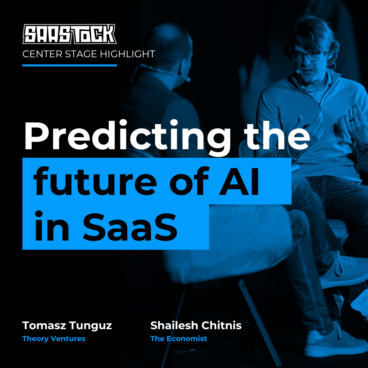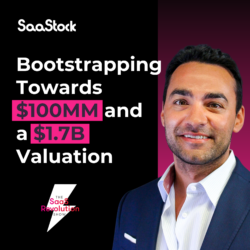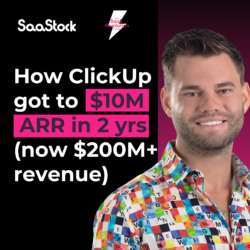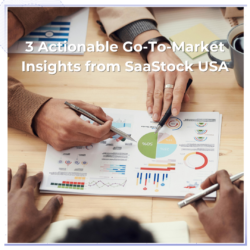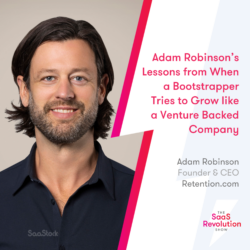Is AI going to eat the SaaS industry?
Almost two and half years since the launch of ChatGPT, the AI train shows no signs of slowing down. But has AI started to deliver on its ‘revolutionising’ promise and how will it impact the software market?
During SaaStock Europe, Tomasz Tunguz, General Partner of AI investor Theory Ventures, gave his take on AI’s state of play, its potential impact on SaaS fundraising and workflows, and how start-ups could beat the likes of Amazon and Google.
Watch below or read on for a summary of the top 5 insights.
What is AI’s current ability?
AI investors judge AI’s ability in terms of human replacement – similar to how robots replaced three humans in the manufacturing assembly line. But AI hasn’t got there yet. At the moment, companies with the most sophisticated AI like Microsoft are reporting a 50-75% productivity improvement as a result of using AI co-pilots. Their state-of-the-art AI has the intelligence of a GCSE or high school equivalency graduate and an accuracy of 70-75% for a single task. But the error rate compounds for each task, so after just three steps, you have an accuracy of 55-60%, which is nowhere near enough for high level work.
How will AI impact SaaS margins?
It depends what you do. If you’re a startup that’s using other people’s AI models, your margins will only improve as AI costs fall. For instance, when OpenAI cut its costs by about 50%, one of our portfolio companies doubled their gross margin overnight (and DeepSeek now promises top-tier performance at 1/40th the cost of previous models).
If you’re creating your own AI model, you can also charge a premium for your AI features. For example, Salesforce charges around $175 to buy a seat for a salesperson, but $500 if you want to add its AI features.
However, I also think we will see companies buying a lot less off-the-shelf software. For instance, if you are a large enterprise generating around $750 million in revenue, you’re probably spending $1-12 million a year on your CRM seat licenses alone (not including accounts executives). Could you build better software yourself for $10 million a year? If so, you probably will.
How is AI funding affecting SaaS fundraising?
If you’re AI SaaS, raising funds is as easy as the 2022 heyday. Some AI companies are even raising at 500 times ARR. But this level of investment reduces the available funding pot for the rest of the general software market.
To make matters worse, the decreasing number of mergers, acquisitions and exits is reducing venture capital’s appetite for non-AI mid stage software companies as investors aren’t getting their returns. For example, since the roll-out of US Federal Trade Commission regulations, the most active software acquirers have gone from buying 25-30 companies per year to just three.
So if you’re a SaaS company outside of the AI world, it’s essential to have 12-18 months of cash runway and be driving close to profitability.
How will AI disrupt software workflows?
Many SaaS products have been designed for specific workflows. Take Salesforce, for example. They created a playbook to sell software in one very particular way: the classic SDR to AE path.
But AI will change the way we sell. 2-3 years from now, BDRs will not manage a single email inbox, but instead manage 50 AI-controlled inboxes, so the job will evolve from direct selling to managing robots.
This fundamental change will happen for every internal workflow – be it HR, marketing or even software engineering. If incumbents are too set in their ways, then startups could actually unseat those incumbents by changing the underlying workflow. That’s the big bet in AI – and the reason why VCs are so excited. By reimagining the whole workflow with AI, all the market cap that incumbents have will be up for grabs.
How can startups win in the AI world?
The dominant narrative is that hyperscalers like Google, Amazon and Facebook will win as they simply have more people, more algorithms, more data and more capital. But startups that focus on vertical applications and find niche solutions can also win big.
At the moment, software accounts for just 3-5% of operating budgets and yet a trillion dollars of market cap has been created focusing on that 3-5%.
But AI companies aren’t focused on replacing email security workflows. They’re trying to replace humans and labour costs have budgets 15-20x larger than software budgets. As a startup, that means you don’t need to capture the same amount of market cap to become a public company. You don’t need 20% of the email security spend or 15% of the email marketing world. You just need 0.5% of the labour budget in sales development or marketing automation or security analysis to go public.
Hear more from Tomasz on The SaaS Revolution Show.
SaaStock Europe 2025: Where AI meets ARR
SaaStock Europe is where where the next generation of AI and SaaS founders build, connect, and scale
Join us for curated content from top AI and SaaS voices, and the industry’s largest 1:1 meetings programme.
Come to hit your 2025 goals and stay for the conversations that change your business in 2026 at the definitive gathering for AI & SaaS founders, funders, and operators.
